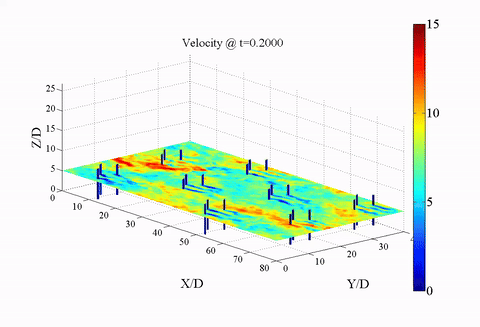Welcome to the Thermofluids of Urban and Natural Environments - TUNE LAB at Princeton University. Combining numerical, experimental, and analytical approaches, we study the basic dynamics of flow and transport in environmental systems, and how these dynamics relate to problems in urban microclimatology, hydrology, air quality, meteorology, and renewable energy.
The current research interests of our group center on the physical processes at the interface between the atmosphere and the Earth surface. We seek to understand their attributes and coupling, as well as to develop prognostic models for their dynamics. Most human activities and engineered systems, and their interaction with natural systems, are concentrated near that interface, in the atmospheric boundary layer and the underlying land or sea surface layers. Therefore, we need to be able to describe these layers in much more detail than the ancient Greeks did (geophysics in ancient Greece.)
The relevant physics we investigate hence span turbulence dynamics in the lower atmosphere, the influence of buoyancy forces and rotation on these flows, and heat, carbon, water exchanges between the Earth surface and the atmosphere. We have examined how these processes shape various Earth and Anthropic systems including the polar marginal ice zones, vineyards, glaciers, coastal areas, lakes, tropical rain forests, and savannas; however, a particular focus of our research efforts are built surfaces and urban environments, where 70% of the world population will reside by 2050.
For more information and details about our work please visit the different pages of our site or contact a member of our team.

Turbulent Eddies in a Baroclinic ABL
Fundamentals: Environmental Turbulence and Fluid Mechanics
At the center of our fluid mechanics and turbulence research are the dynamics of the atmospheric boundary layer (ABL) that spans the lowest 1 km or so of the atmosphere, i.e. the strata that we live in. Its dynamics are highly dependent on its interaction with the heterogeneous Earth surface and on the diurnal cycle of solar radiation. Hence, the temperature, wind, and trace gas concentrations in the ABL vary at smaller spatial and temporal scales than the rest of the atmosphere. While historically we have focused on how its dynamics impact weather and climate systems or agriculture and water resources, new applications related to solar and wind energy and urban environmental quality are beginning to dominate our interest in its meteorology. These new applications uncover vast gaps in our grasp of the fundamental physics and dynamics of boundary-layer meteorology, and frame the research of our lab. Luckily, we are living in a golden age for Earth Sciences where massive computations, novel sensors, and artificial intelligence can be combined to develop new theoretical understanding and the advanced predictive and prescriptive skills needed to face these emerging grand challenges.
Domains: Cities and the Urban Environment
Cities are the chaotic intersection of geophysical, infrastructure, and socio-political systems. About 57% of the world population now lives in cities, and they contribute disproportionately to economic production, energy and resource consumption, and greenhouse gas emissions. They are also exposed to the most severe pollution, extreme heat, and destructive floods. It is thus clear that our future as a human species is intimately linked to how we develop existing cities and build new ones. Our lab focuses on understanding how urban form, fabric, and function modulate urban environmental quality, and how they determine the response of cities and their infrastructure to weather and climate extremes. More importantly, we design and investigate solutions that modulate air flow and heat transfer in urban terrain to make our cities more sustainable, resilient, livable and equitable. We invariably aim to combine multiple modeling scales and approaches, in-situ and remote sensing, and fundamental thermodynamic theory in our quest to design better future cities.

Smoke visualization with different roof geometries

LES of vertical axis wind turbines farm
Applications: Energy, Hydrology, and Climatology
Fluid flow and turbulence directly impact a myriad problem and application in environmental engineering and geophysics. Our lab expertise in the theory, models and observations of environmental fluids and thermodynamics are therefore often applied in many areas. Hydrology and the water cycle, and its intimate links to the carbon cycle, are central applications areas where we investigate how evaporation cools cities and how turbulence information can help us partition land fluxes from the soil versus vegetation. The interaction of the ABL with sea ice and its role in the polar amplification, and the ability to model atmosphere and cryosphere dynamics are another domain of interest for our lab that ties to our broader work on surface heterogeneity and secondary thermal breezes in the lower atmosphere (land-sea breezes and urban-rural breezes, for example). Last but not least, the energy challenge motivates our work on wind energy (vertical axis turbines farm design and wind energy forecasting) and solar energy (agrivoltaic and urban photovoltaic applications).
